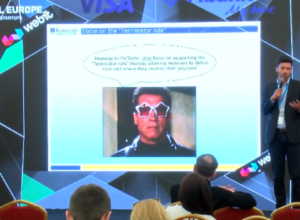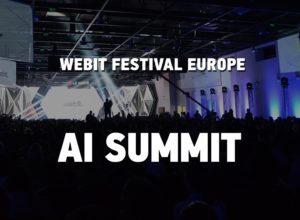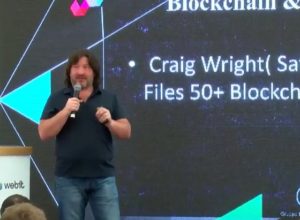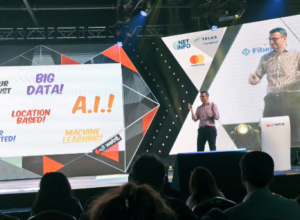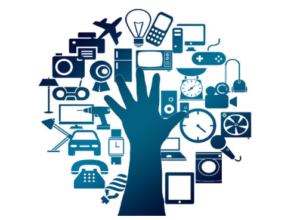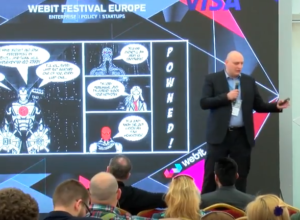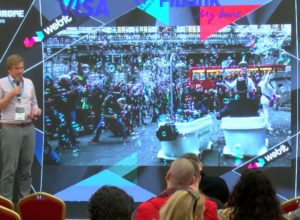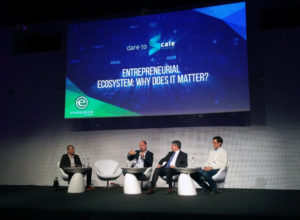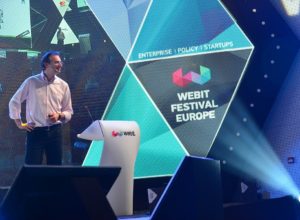Tag: Webit
Trends in cross-border payments
[embed]https://www.youtube.com/watch?v=OsBtydb2Pqc&t[/embed]
2017 Webit stage saw the cooperation of two people - the one with years of experience in the sphere of fintech - Michel Stuijt, the CEO of Eurogiro, and the great, innovative mind Or Benoz, co-founder of Rewire. They both investigated the trends in cross-border payments.
In his experience, Michel opens the discussion, he outlined a four expectations of what people see in the future of payments:
-
Free
-
Fast, if not instant
-
Secure
-
Full withdrawal
The main trend, the future in financial technology, lies in the cooperation.
The duo on the stage is quite a good example - the financial institution Eurogiro and the innovative products Rewire create is a great example in cross border cooperation. In 20 years time the only solution for regulation of the blockchain, fintech, trading, transactions, etc, is the good cooperation between all stakeholders. Because, let’s face it - there are few companies that create new technologies in the world today. In 5 - 10 years from now, we will see many technology companies focusing on consumer experience, making the experience amazing; on the opposite side, the financial institutions, organizations, etc, already have financial instruments, licenses and the infrastructure. The future of cross border payments lies in the cooperation between both ways.Humanistic Trans-humanism
“Some technology solutions may not only erase physical or mental deficits but leave patients better off than ‘able-bodied’ folks. The person who has a dis-ability today may have a super-ability tomorrow.”
Stephen HawkingWhat are the “assistive technologies”?
check the upcoming 👉 Webit.Festival 2018
Simply put, this is a technology that is used to increase, maintain, or improve the functional capabilities of people with disabilities. To give you a quick glimpse into understanding, the name Stephen Hawking would help. Hawking has experimented with numerous technologies of this kind. He has communicated using a spelling card, indicating letters and forming words with a lift of his eyebrows. Then, with the help of a computer program allowing him to select words and commands using a hand clicker linked to a speech synthesizer, he has obtained a voice. By moving a single muscle on his cheek and selecting characters from a software screen keyboard, he is able to deliver his thoughts. Normally, one would say that such technology is good for people with disabilities. That way they can:- continue learning or
- be able to maintain a profession.
Technology has played an immense role in helping scientists invent different devices in order to help people with disabilities.
There are hearing devices already put in use, eye tracking and brain controlled interfaces that help to communicate with a computer. Developments towards making artificial retinal implant that can restore lost vision, cars for blind people, exoskeletons assisting people with movement difficulties, enhanced learning for people with learning disabilities that measures and stimulates the brain’s activity. And the big top: brain computer interfaces - a direct communication pathway between an enhanced or wired brain and an external device. The use and progress of Artificial Intelligence is a big stake in improving people’s lives but the thing is that these technologies are being constantly developed and people have benefited from this but these same people are not so many at all 60% of the people are afraid of the progress in AI and robotics. How much will they develop? Will the scenarios from almost all Hollywood movies on the theme shift to reality? We will just have to wait till 2045 and see if Ray Kurzweil’s prediction about the Singularity Point will turn up to be true and whether AI will be developed to such an extent that we’ll be able to merge with it. Watch the full keynote of Maurice Grinberg, Director of HiLab for getting a wider perspective on what AI is here: [embed]https://www.youtube.com/watch?v=ZYPrwZqE9vo[/embed]Intangible assets – blockchain relation
Do your friends ever talk about blockchain, fintech, transactions, etc.. and you just sit there not knowing what to say? Alexander Shulgin is here to bring some light and educate us on these terms.
Bitcoin, he explains, is not a currency, although we use it like that. It is in fact a decentralized distribution data based technology based on trust, used for transactions, agreements, etc.
 The infographic shows the starts of tomorrow and they are based on patent IP and full copyright.
A case study that Alexander presents can be seen here:
[embed]https://www.youtube.com/watch?v=ZScSjPjPEqg[/embed]
Keep up with Webit.Festival 2018 agenda with a series of startup events such as the Founders Games, Startups & Investors Summit, nurturing the connection between these two intertwined parties. And more.
The infographic shows the starts of tomorrow and they are based on patent IP and full copyright.
A case study that Alexander presents can be seen here:
[embed]https://www.youtube.com/watch?v=ZScSjPjPEqg[/embed]
Keep up with Webit.Festival 2018 agenda with a series of startup events such as the Founders Games, Startups & Investors Summit, nurturing the connection between these two intertwined parties. And more.
Do you believe that blockchain affects only banks and banking institutions? Well, you are wrong.
The first companies to use this technology were not banks, nor are the ones that use it today - companies like Apple, Alphabet, Microsoft, Exxon Mobile. It will disrupt firstly intellectual property, for example, as well as other intangible assets. Nowadays, a priority of all the businesses is to establish a global database for intangible assets. Without them, businesses cannot do any IoT, anything that is based on blockchain. It became clear that blockchain and Intangible assets go hand in hand, but they also create a platform for- knowledge economy and
- creative economy
 The infographic shows the starts of tomorrow and they are based on patent IP and full copyright.
A case study that Alexander presents can be seen here:
[embed]https://www.youtube.com/watch?v=ZScSjPjPEqg[/embed]
Keep up with Webit.Festival 2018 agenda with a series of startup events such as the Founders Games, Startups & Investors Summit, nurturing the connection between these two intertwined parties. And more.
The infographic shows the starts of tomorrow and they are based on patent IP and full copyright.
A case study that Alexander presents can be seen here:
[embed]https://www.youtube.com/watch?v=ZScSjPjPEqg[/embed]
Keep up with Webit.Festival 2018 agenda with a series of startup events such as the Founders Games, Startups & Investors Summit, nurturing the connection between these two intertwined parties. And more. It’s evolution, baby!
Starting by examining the opinion of Webit’s Blue Stage audience on their belief in evolution or if God made it all, Michael Schuster, partner at Speedinvest, managed to deliver a pretty helpful and interestingly funny presentation on the topic of the two main intertwined disruptors in business: startups and investors.
Tides turn and seasons change, yesterday’s predator becomes today’s prey. Why are some companies around for tens or a hundred of years already, be it Siemens, IBM, and whatever company acknowledged by everyone as a steady rock in business, while others don’t survive the light of the next day?
Schuster presented the ideal graph of a startup funding escalation:
А startup is launched with friends, family, getting private and angels’ investments, then going through series of rounds and going up and up until the one point IPO. It would’ve been nice if every startup story goes this way, but most of the times it doesn’t happen as ideal as this. Startups “start”, get whatever help possible, moving from getting seed investments to almost disappearing, going up and down until the moment of breaking through the market or collapsing and disappearing. For a startup, what is essential before the run for scaling, acquisitions and becoming unicorns, is that: you just need to survive. And in order to survive in the world and not become an extinct dinosaur, the law of evolution applies pretty much for startups too: it is not the strongest of the species that survive, nor the most intelligent, but the one most responsive to change. Both statistics and reality show well enough the differences between the european and US markets. The business models applied in the latter don’t always work that well in the european market which is not always taken in enough consideration. Funny enough, investment companies, as an industry that is actually funding disruption hasn’t been disrupted itself in a long while. A lot of things need to be considered by startups while trying to get the attention of investors and customers. Big, trendy words like AI, customer centric, big data and so on are constantly thrown at the funding companies; startups are chasing investors not quite suited for them and accelerators way before the time for this has come while missing some important points.If you are interested in learning what they are, check the full video of Schuster’s presentation at last year’s Webit here: [embed]https://www.youtube.com/watch?v=KZRUcoHxn-c[/embed] Keep up with Webit.Festival 2018 agenda with a series of startup events such as the Founders Games, Startups & Investors Summit, nurturing the connection between thesе two intertwined parties. And more.The IoT tide
“If we had computers that knew everything there was to know about things - using data they gathered without any help from us - we would be able to track and count everything, and greatly reduce waste, loss and cost. We would know when things needed replacing, repairing or recalling, and whether they were fresh or past their best.” Kevin Ashton, digital innovation expert, credited with coining the term “Internet of Things”.
Let’s look at an example
In 2007, a bridge in Minnesota collapsed because of steel plates that were inadequate to handle the bridge’s load, resulting in many people being hurt. It’s one of the most catastrophic in terms of injured people, but many similar incidents are happening everywhere in the world. Despite periodic checkups of the structures, engineers and other staff involved couldn’t predict the exact moment a problem like this would occur.That’s where IoT can come in handy
When bridges or other massive structures are build or rebuild, instead of a regular one, a smart cement could be used - a cement equipped with sensors to monitor stresses, cracks, and warpage that signals when a problem arises and gets fixed before it causes a catastrophe. If the road on a bridge or any motorway and street is slippery, the same sensors would detect the hazard and communicate the information to the driver’s car. Once the car detects the hazard ahead, it indicates the driver to slow down or the car itself would slow down for him. Sensors on the bridge will connect and communicate with machines in the car, information is then turned into action. And these technologies aren’t limited only to a bridge’s structure. If policy makers and businesses get it right, linking the physical and digital worlds could generate up to $11.1 trillion a year in economic value by 2025. Currently, most of the data gathered by IoT systems and devices is not used. Cloud-based applications are the key to using leveraged data. The Internet of Things doesn’t function without cloud-based applications to interpret and transmit the data coming from all these sensors. The cloud is what enables the apps to work best anywhere and anytime.The game-changer
MClimate (Melissa Climate) is an IoT company which changes the way people use the appliances they already have. Its cloud system connects the heating and cooling system in one’s home, so an actual insight and control is gained of over 70% of an electricity bill. Their devices learn your preferences and habits - what temperature you are most comfortable with, when you usually get home, how long it takes for your HVAC system to cool down/heat up etc. Melissa climate won a Webit Award in the category Best Connected Consumer Electronics Device at Webit.Festival 2017. You can watch Lyubomir Yanchev’s pitch right here: [embed]https://www.youtube.com/watch?v=5d0gXq7cYpk[/embed] Stay up to date with the upcoming festival’s agenda here. If you wish to learn more about the IoT, you can check this article in Forbes magazine.Risk assessment is dead! Be risk aware.
Let’s put a cyber security smile on the face of your top docs.
In his presentation @Webit.Festival Europe, Boris Goncharov, a leading cyber security strategist, explained a rather boring subject - cyber security threats. And he did it with a story and fictional characters that he created himself! Boris Goncharov’s character - Captain Ciso, is the great defender of the Business city - the city where all the capital is - human, money, business doing, whatever. While he used to save data, defend the city and its citizens from malware, the situation is changed now. One the one hand, the villains express your organisation’s vulnerability. Next the Business city is attacked by bots and the worst type of threat is the very invisible one that never leaves traces and you never it was ever there. The city entered the 21st century. So did the Captain - along with Artificial intelligence on his side, he started using the combination of CMA - DTA - CDSS. This is the logic of the cyber security management of the future. This is the newest way to defeat your cyber security operations and will allow you to continue to monitor, correlate the state of these controls with the external environment. In order to do all this, you need to be aware of the external environment - a common mistake that everybody does - not making a risk evaluation. Once done, this brings nothing but knowledge - action needs to be taken, because threats are all around us. That’s why it’s vital to understand the correlation between your environment and what you can do. The solutions don’t change as much as the treats do. Risk assessment is dead! Today we have to be risk aware every minute. You can watch the full keynote of the captain here: [embed]https://www.youtube.com/watch?v=bNs_YFhe19c[/embed] If you want to stay up to date with the latest trends in security and privacy, Webit.Festival Sofia 2018 is the place for that. Visit our website and check the different ticket options.The future tech of money
Money and payments - an intriguing theme ever since way back in time, becoming more and more intriguing with each passing day. What makes it even more appealing is the never ceasing research and emerging tech innovations in the field. Blockchain, Bitcoin, international trade, digital currencies are in the focus and interest of not only corporations as a main actor, but for individuals too.
That brings the questions Kristo Kaarmann CEO of TransferWise, was trying to answer at Webit.Festival Sofia 2017. What is the future tech of money? Is it going to be Bitcoin? Ethereum? Or another type of blockchain currency? Are we still going to have banks in 10 years time or we’ll do banking on Google? Who can make a 100% certain statement and predict what and when will replace a financial system which is working, trusted and being accepted by many all around the world?
Kaarmann made an emphasis on an article published by The Guardian “Big banks earning huge profits from overseas money transfers”. Banks get their profits from different exchange rates, transfer fees, and fees on other services which are far from the cheapest option to manage one’s money. In recent years there has been a flood of fintech companies offering their solutions to individuals, corporations and banks themselves and at much more reasonable rate.
There are very few problems where tech is the only possible solution. Very often the solution lies not just in technology, but in technology and the things around it - governments, legislation, working with different institutions. For example, in fintech, that could be as specific as blockchain patterns and the governments’ enforcements on them through the more global issues such as acceptance of the new models and novelties by people. In order to find the answers of all the questions the financial system has yet to clarify, we’ll just need to wait for it to present and see.
You can watch the full keynote of Kristo Kaarmann here:
https://youtu.be/CWhI7UgRJLw
If you want to stay up to date with the latest trends in fintech, money & payments, Webit.Festival Sofia 2018 is the place for that. Visit our website and check the different ticket options.
Feel the Webit vibe with some of the best photos from this year’s event!
[easingslider id="4954"]
Entrepreneurial Ecosystem: Why does it matter?
At Endeavour's Dare to Scale Rosen Plevneliev - the president of Bulgaria 2012-2017, Fernando Fabre - president of Enveavor Global, Vassil Terziev - Co-founder of Telerik Acacdemy had a panel discussion about the value about Entrepreneurial Ecosystem, moderated by Plamen Russev - Chairman of WEBIT Foundation.
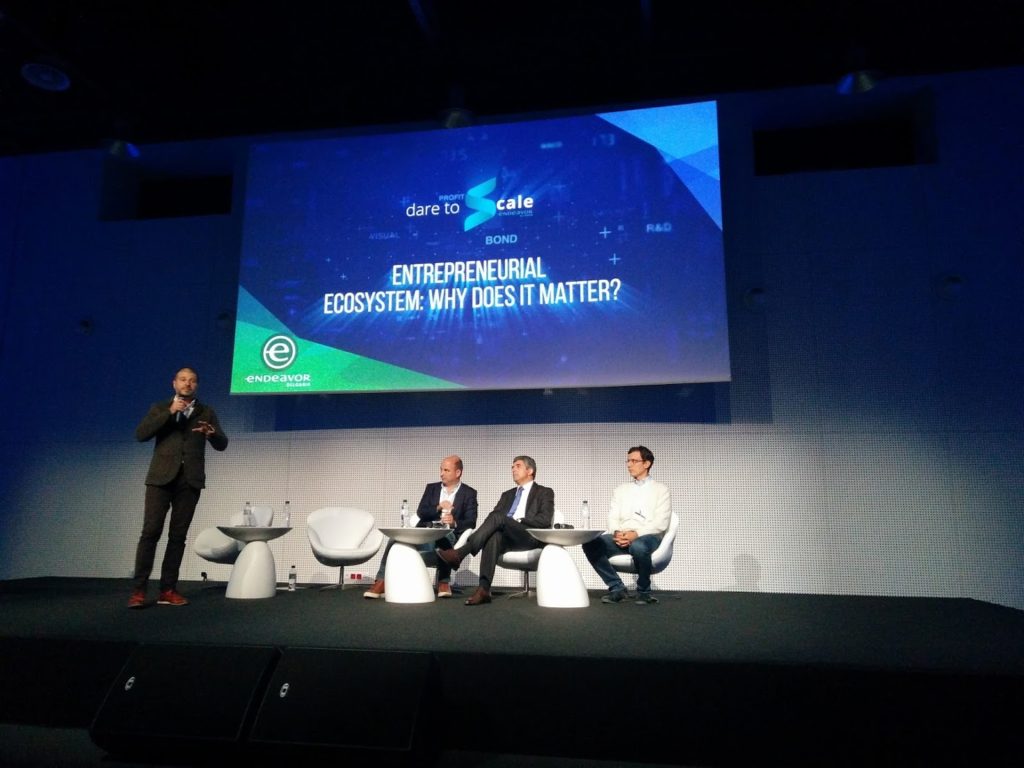 Webit Foundation commits its annual funds to foster the development of the startup and innovation ecosystems in the regions our global events take place.
Founders Games is the startup competition in the program of Webit.Festival Europe. During the event we not only provide free grant for startups to get a free expo table, free festival tickets and opportunity to meet unparalleled selection top enterprise leaders from all around the world + investors, but also an opportunity to WIN €200 000 seed investment!
Find out more about the Founder games here.
Webit Foundation commits its annual funds to foster the development of the startup and innovation ecosystems in the regions our global events take place.
Founders Games is the startup competition in the program of Webit.Festival Europe. During the event we not only provide free grant for startups to get a free expo table, free festival tickets and opportunity to meet unparalleled selection top enterprise leaders from all around the world + investors, but also an opportunity to WIN €200 000 seed investment!
Find out more about the Founder games here.
Strengths to focus on and weaknesses to work on
The discussion went through 3 stages - Bulgaria, Region and Global. Vassil Terziev took over the first stage going through the last 10 years of developing an entrepreneurial spirit in Bulgaria and bringing all the components of a working Ecosystem together. They include people, events which gather several thousand people together talking about the future. New and new formats are coming to Bulgaria every year. "The growth is a function not only of time, but also of communication and aligning the economic interests. In order something to be sustainable it has to make sense for everybody involved. And this is what is still missing." - mr. Terziev said, but staying still optimistic about what the Technology Ecosystem that's being built can do for the other sectors in Bulgaria.It's a kind of magic
"I believe in magic big time. We need the magic of giving back." mr. Plamen Russev We already have the Ecosystem startups and they are growing but do we need to focus on scale ups more? "They will make Bulgaria a better place, Through WEBIT, through Enveavor and other formats we will build those scale ups who will give back to the community." We need an ecosystem where every single person grows within the idea that he or she has to give back to the community – like the Israerli ecosystem. “You can’t say “I’ve done enough, now it’s time to give back” – no, you give back all the time. ”The Local Heroes
Mr. Rosen Plevneliev talked about the ambition of Bulgaria and how he shared his thoughts with several entrepreneurs in the Silicon Valley. “You are as big as your dreams are, not as big as your territory is. And to be globally strong, we need to be locally strong. This is what you, the local heroes are doing right now.”A map of ecosystems
Mr. Fernando Fabre took the audience on a world tour of the Ecosystems – from Buenos Aires, Mexico City, Silicon Valley, New York to Tel Aviv, Beirut and so on. He shared his opinion that it all goes down to inspiration. Big entrepreneurs inspire others – they grow and do the same – thus multiplying the mindset. “You call it giving back, Local heroes, I call it multiplying effect these are three terms that are exactly the same.” Webit Foundation commits its annual funds to foster the development of the startup and innovation ecosystems in the regions our global events take place.
Founders Games is the startup competition in the program of Webit.Festival Europe. During the event we not only provide free grant for startups to get a free expo table, free festival tickets and opportunity to meet unparalleled selection top enterprise leaders from all around the world + investors, but also an opportunity to WIN €200 000 seed investment!
Find out more about the Founder games here.
Webit Foundation commits its annual funds to foster the development of the startup and innovation ecosystems in the regions our global events take place.
Founders Games is the startup competition in the program of Webit.Festival Europe. During the event we not only provide free grant for startups to get a free expo table, free festival tickets and opportunity to meet unparalleled selection top enterprise leaders from all around the world + investors, but also an opportunity to WIN €200 000 seed investment!
Find out more about the Founder games here. How to market and sell when the act of purchase disappears
The act of purchase as we know it is progressively disappearing. Driving forces of it are the usual forces standing behind each global change happening: growing and aging population, higher standard of living, climate changes and scarce resources. Nowadays, we can also add the growing presence of digital in everyday’s life and the ever changing consumer behavior.
The VP Digital Transformation of SCA Gael de Talhouet gave quite an insightful keynote at Webit. Festival 2017 in Sofia concerning the change in the customer of tomorrow.
How do you sell products in a world where no one buys anything anymore? We’re moving from a world where we click, purchase, pay and collect to a world where we will just need to ask, because robots will know our needs.
More and more companies are introducing their subscriptions models, allowing us to get the things we want directly delivered to our homes without the need of going physically to get them from the shop. Amazon has developed the dash buttons which after being connected to your smartphone and pressed, the product you’ve chosen is automatically reordered. You don’t need to order, you just receive. Or speak, as in the case with Amazon Echo. Just ask, tell the device what you need, and it will find it for you.
The next step is when you don’t even need to speak. Fridges indicating the products that are missing from it, making lists of what needs to be purchased, washing machines and printers automatically ordering physical goods when supplies are running low. Smart devices noticing when you have a dinner with the friend who loves pizza or if you’re in need of a specific vitamins, asking to make an order for you. Or suggesting you a herbal detox tea after noticing you’ve woken up early and had a week full of meetings. It’s not rocket science, it’s history browsing and predictive analytics
And what if these devices can recognise our emotions? Scientists and are relentlessly working on and getting closer to breakthrough in the face of voice assistants.
The future of shopping is no shopping. People will not buy anymore because robots will buy. That brings the next question, how do you sell to a robot? Who will the robot buy from and how will it make the choice? Marketing strategies used to be consumer centric, while when this becomes a basis, companies will need to figure out is how to convince a robot to become their client. After digital marketing and e-commerce, welcome to robotic marketing and e-commerce.
You can watch the keynote of Gael here:
https://www.youtube.com/watch?v=SsT8LuHVg8s
Webit.Festival 2018 will gather again top speakers, policy makers and enterprise leaders. Stay up to date with our upcoming guests and agenda on our website and learn more about our ticket options.
Feel the Webit vibe with some of the best photos from this year’s event!
[easingslider id="4954"]
